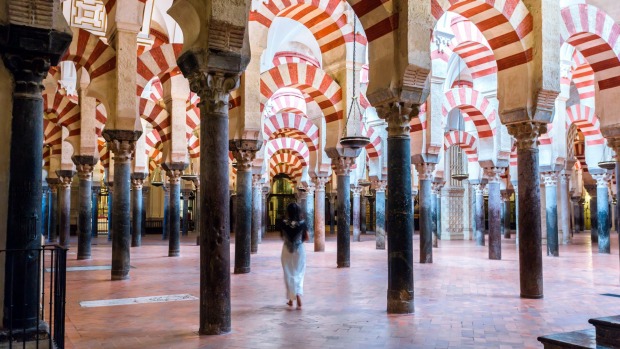
As we enter Cordoba's world-famous cathedral, Bach's most famous composition - his Toccata and Fugue in D minor with its unmistakably dramatic opening bars - begins both suddenly and very loudly. Yes, it is spooky. Surely, they can't do this for every visitor who pays their $10 to enter the Cathedral of Our Lady of the Assumption?
And then we turn the corner from the original Islamic half of the cathedral to the newer Christian chancel and choir quarter, and see a visible human playing one of Christianity's most revered clerical compositions on an equally historic and celebrated 17th century organ.
Why wouldn't a visible human be playing Cordoba's most famous organ?
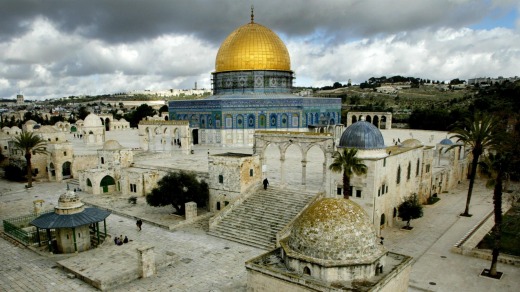
Because, as Enrique (our beautifully tailored Insight Vacations Cordoba city guide) quickly informs us, the organ's stops, keys and pedals can now be played remotely, from other countries let alone other cities, thanks to the wonders of the internet.
The moral of the story is already clear. In the 21st century, the rich, huge and spiritual sound of Bach's fugue we are now hearing is a wonderfully musical demonstration of how a building as beautiful and evocative as Cordoba Cathedral is constantly evolving.
And, this is a building that has changed more than most over the centuries. A unique mix of architectural styles, it is a veritable history of Spain in stone.
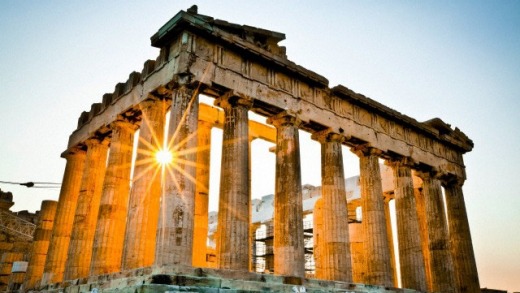
But surely there's some mistake? How can a building that was a mosque later turn into a church, given that Christ predated Muhammad by about 570 years?
Welcome to the wonderful world of religious appropriation. Humans have probably been doing it even before we emerged from caves. You don't need to be a psychologist, a historian or even a spiritual leader to recognise the ground rules. If you want to supplant someone else's faith with yours, simply capture their most sacred space, wait a few years, and re-advertise it as your own.
Enrique has already demonstrated this within a couple of minutes of entering Cordoba Cathedral. Standing over a sheet of toughened glass over an exposed part of the cathedral's foundations, he explains this building's many spiritual reincarnations.
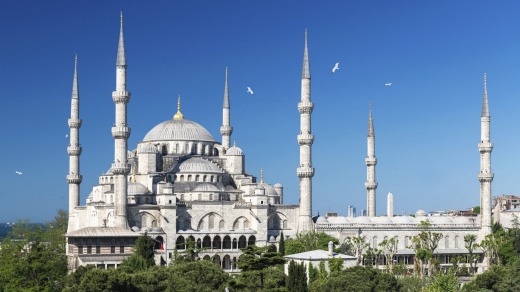
It began, he says, as a Roman temple dedicated to the god Janus. Then it became St Vincent's - a Catholic church built by the Visigoths. A few centuries later, it was converted into a Islamic mosque when the Moors took over Cordoba in the 8th century. And finally it reverted to a Christian cathedral after the Reconquista in the 13th century.
As soon as you walk into the cathedral and are greeted by the scores of amazing marble pillars and famously red-and-white horseshoe-shaped arches of the Islamic prayer hall you realise why the former mosque was considered one of the wonders of the Islamic world.
Enrique explains how the conquering Moorish prince, Abd al Rahman I, vowed to create a grand mosque that rivalled those of Jerusalem, Damascus, Baghdad and even Mecca itself. He achieved his aim.
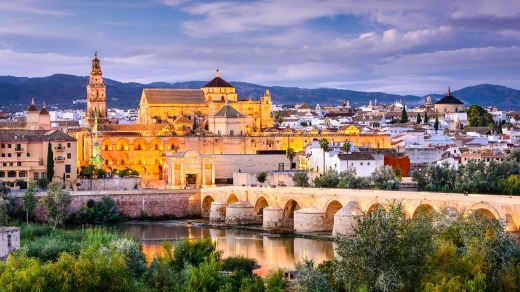
And yet, the Islamic prince seems to have respected the views of the Christians and Jews who also lived in Cordoba.
In the immediate aftermath of the Islamic conquest, both Muslims and Christians were allowed to worship in parts of the building. Then, before construction of his huge mosque began, Abd al Rahman I negotiated with the Christians to buy their part of the site in return for building a new church on a different site.
Construction of the mosque started in AD784. It employed thousands of stonemasons and other artisans. Over the next two centuries, "the Mezquita-Catedral" (as locals call it) was enlarged and made even more glorious under Abd al Rahman I's successors until it reached its present enormous floor plan in 987 AD.
Yet (as another spiritual being, the ex-Beatle George Harrison famously said, misquoting the Bible), all things must pass. In 1236, Christian forces reconquered Cordoba, and the great mosque became a Christian cathedral.
For several centuries, the church remained much the same as it had been.
And then - suddenly in the 16th century - Cordoba was the victim of what many regard as one of the worst examples of religious vandalism in history.
In 1523, the cathedral authorities - opposed by the city council but backed by King Carlos of Castile and Aragon - began building a massive chancel and choir, in very middle of the mosque.
How bizarre a decision this was is best seen from an aerial photo. It's as if a typical soaring Gothic/Renaissance-style cathedral has suddenly fallen from the sky into the middle of a flat-roofed rectangular, Mecca-facing mosque.
Apparently Carlos had never seen the mosque beforehand, but when he came to Cordoba for the unveiling of the new parts of the cathedral, he reportedly said in disgust: "You have built here what you might have built anywhere, but you have destroyed what was unique in the world."
And, yet despite the horror of that decision to build something so absurdly out of place in the middle of such an original building, I have to admit - wandering around the cathedral-mosque is a wondrously giddy, ridiculously over-the-top, utterly magical experience.
Cordoba Cathedral not only appears larger on the inside, but more comfortable, more impressive and more logical.
Of course, Cordoba isn't the only city in the world to boast a major tourist attraction that has served as a place of worship for different, often competing, religions.
A century before Cordoba's clerical authorities decided on their act of vandalism, their Sevillano equivalents had decided to build their new place of worship, reputedly with the words: "Let us build a church so beautiful and so grand that those who see it finished will think we are mad."
Even so, those 15th century builders made use of several features of the mosque - most notably its towering 12th century Islamic minaret, subsequently converted into arguably Seville's most distinctive feature, the Catholic bell tower La Giralda.
The same is true of the Balkan countries and modern Turkey. Which got me thinking. What other churches have become mosques, or vice versa? Which notable ancient temples have metamorphosed into a new identity as the poster boy/girl of a vibrant emerging faith?
When the Ottoman Empire began in 1453 with the successful invasion of Constantinople, Hagia Sophia was converted into a mosque. It remained as such until the first president of the new Turkish secular republic, Ataturk (better known to Australians as Mustafa Kemal, the decisive Turkish general opposing the Anzacs at Gallipoli), declared it should become a national museum in 1935.
Take it from a sceptic. Temple Mount is a very small summit, certainly not a mountain by any stretch of the imagination. Yet it is sacred to three of the world's most contentious religions.
Jews believe this is the site of the Solomon's biblical temple which housed the Ark of the Covenant, containing the Ten Commandments handed down to Moses, before it was destroyed by King Nebuchadnezzar II who captured Jerusalem in 597BC. They also believe this was where Abraham was prepared to sacrifice his only son Isaac
Christians believe Jesus not only walked over this hill, but overturned the tables of the moneychangers who were operating from the second Jewish temple of this spot, usually referred to as Herod's Temple.
And Muslims believe the achingly beautiful Dome of the Rock - the octagonal, exquisitely-tiled, gold-roofed Islamic shrine completed in AD691 - marks the spot where Muhammad ascended to heaven.
Yes, we are talking about the most famous temple in the entire ancient world, standing atop the mighty Acropolis and dedicated to the goddess Athena for a least 1000 years.
And yet, during the time when Byzantium-Constantinople was the capital of the Eastern Roman Empire, the Parthenon was a converted church, dedicated to the Virgin Mary, Mother of God.
The original Pantheon, commissioned under the auspices of Emperor Augustus about the the time of the birth of Christ, is no more. It burnt down, but was rebuilt almost 2000 years ago by the Emperor Hadrian, about AD126.
Since the 7th century, this hallowed building has been a Roman Catholic church, dedicated to St Mary and the Martyrs. The fact most visitors see it as magnificently pagan is a triumph, I'm told, of hope over experience.
Built in 1743 and one of the oldest surviving buildings in the East End of London, the Brick Lane Great Mosque
was originally a Protestant chapel, built by the Huguenots who had fled France to escape Catholic persecution. In the late 19th century as Spitalfields Great Synagogue, it served the Jewish refugees who had settled in the area after fleeing Russia and eastern Europe.
As the Jews moved out to wealthier suburbs, the Spitalfields area became populated predominantly by Bangladeshis. Since 1976, the building has operated as a mosque.
It's not actually built yet, but in 2014 a Protestant pastor, a rabbi and an imam announced plans to create the world's first house of prayer to be shared by Christians, Jews and Muslims.
The House of One, as it is called, is due to open in 2018. Designed by architect Wilfried Kuehn it will contain a church, synagogue and mosque under the one roof.
Now isn't that an idea which would solve a lot of problems!
catedraldecordoba.es
Emirates has three daily flights from Sydney and Melbourne, via Dubai to Lisbon with connecting flights to Cordoba with Iberia Airlines. See emirates.com.au.
Insight Vacations' nine-day Highlights of Spain visits Barcelona, Valencia, Granada, Seville, Madrid and includes a Signature Experience visiting Cordoba with a local expert, priced from $2525 per person, twin share. Phone 1300 301 672, see insightvacations.com.
INSIGHT VACATIONS also operates tours to most of the other cities mentioned in this article.
The writer was a guest of Insight Vacations.